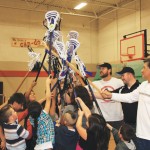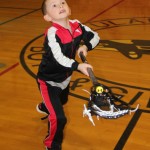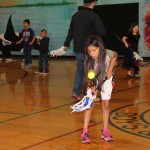
By Kim Kalliber TulalipNews writer; photo by Jeannie Briones, TulalipNews staff
The sound of clashing sticks echoed throughout the Tulalip Boys & Girls Club as kids, club staff and members of Everett’s Washington Stealth lacrosse league took part in the exciting sport of lacrosse. Members of Washington Stealth paid a visit to the club on February 11th to teach the kids not only the game of lacrosse, but its history and Native American cultural identity, along with the importance of staying physically fit in order to combat obesity, an issue that is prominent in children across America.
The history of Lacrosse
Lacrosse, a word that means “stick,” is one of the oldest team sports in North America, and can be traced to tribal games played by eastern tribes and some Plains Indian tribes in what is now known as Canada. The sport was well established with Europeans by the seventeenth century, and was documented by Jesuit priests.
Traditional lacrosse games were often major events, lasting several days, with as many as 100 to 1,000 men from various villages or tribes playing against each other in a single game. These large number of players would swarm a ball, which could not be touched by hands, and maneuver it across an open field.
Medicine Men served as coaches and women traditionally served refreshments. Games were followed with a ceremonial dance and a large feast to honor the hungry players.
Early lacrosse balls were often made of wood or deerskin stuffed with hair, and the sticks resembled a giant wooden spoon, without netting. No protective gear was worn during traditional lacrosse games.
Blue Pony Lacrosse
Washington Stealth have partnered with Blue Pony Lacrosse, a program dedicated to rejuvenating lacrosse in Native American culture and teaching the history and importance of the game to Natives.
“It is grounded in tradition. It is an Indigenous Native sport, originally part of the medicine game of the Iroquois. We want to start a foundation of understanding more than just the sport, but the spiritually and cultural history behind the sport itself,” said Dave Waterman, Native American Liaison for Washington Stealth. “We will move on to contemporary lacrosse, which is what you see today. Hopefully this will initiate some interest in the youth and in the community.”
For centuries the Iroquois have played the “Creators Game,” sending the message that the game is a symbol of unity, health, and the power of the good mind; it’s message transcends territory, boundary and time, manifesting through the players, representing honor and respect of all people, generating a gift of healing so all people may have peace of mind.
Blue Pony co-sponsored a resolution at the 1996 National Congress of the American Indian, which designated “The Creator’s Game.” Part of this resolution states, “the involvement of Indian Lacrosse with young people may go a long way towards solving the problems faced by Indians in dominant culture schools, the lack of respect for Native culture and history, coupled with racism and an expectation of failure.”
Sticks 2 Schools
Not only are they working to teach the origins and culture of lacrosse, members of Washington Stealth are also educating children about the dangers of obesity, through a partnership with Sticks 2 Schools.
Sticks 2 Schools is a non-profit corporation that helps combat child obesity by motivating youth to increase their level of physical activity while learning to play lacrosse. Since many schools can’t afford additional physical education programs and equipment, Sticks 2 Schools, through corporate sponsors and private donors, has introduced co-ed lacrosse in over 100 elementary, middle and high schools in the Greater San Francisco Bay Area of California, and since 2010, twenty schools in the Greater Seattle area.

“The overlying message is to fight childhood obesity, but so much more comes out of it. They learn leadership skills and communication within their own peer groups,” said Chris Kelley, Manager of Service and Retention for Washington Stealth and lacrosse coach for Mukilteo High School.
“I think the game of lacrosse is a great outlet for the kids to promote the importance of an active, healthy lifestyle while celebrating the history and heritage behind the sport in Native culture,” said Chris
McElroy, Washington Stealth team member.
Let the games begin
Washington Stealth members arrived at the Tulalip Boys & Girls Club, packing equipment, knowledge and team spirit to share with Club kids and staff. Kids were taught the importance of wearing proper helmets and elbow and chin pads and were introduced to the latest sporting equipment. Thanks to modern technology, sticks now increase the pace of the game.
After a pre-game warm-up, the kids got to test their newly learned skills on the court.

The objective of the game is to score by shooting the ball into an opponent’s goal, using the lacrosse stick to catch, carry, and pass the ball. The defense tries to keep the opposing team from scoring and to gain control of the ball through the use of stick checking and body contact or positioning. The game can be played on an outdoor field or indoor court.
“I was born to do this!” said Tulalip Boys & Girls Club member, Andrea Parrish, who proved to be a natural at the game.
As a special surprise, the Tulalip Boys & Girls Club received a gift of 50 lacrosse sticks. The sticks were originally donated to the Sticks 2 Schools program, which passed them on to Tulalip in order to increase the interest in lacrosse among Native American youth.
Unsure of what the future holds for lacrosse at the Tulalip Boys & Girls Club, Don Hatch III, Athletic Director for the club said, “I hope our kids grasp onto this sport; I want them to give it a shot. We are more than just a basketball club now; we have soccer, t-ball, baseball, and football.”
